|
By Dawn Brazell
Public Relations
Eric Monsch walked about the Locomotor Energetics and Assessment Lab
with 65 red lights flashing about his body, 12 cameras mounted high on
the walls monitoring his every move.
This motion capture
system— the same type used by the Black Eyed Peas to animate its latest
music video—is coupled with a split-belt treadmill that measures the
forces acting on Monsch's feet. The data being collected will allow
researchers to create a specific mathematical model of his
musculo-skeletal system with a high power computer.
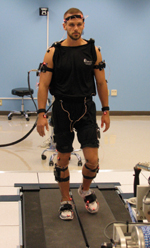 Physical
therapy student Eric Monsch demonstrates the technology in the
locomotor analysis lab. Physical
therapy student Eric Monsch demonstrates the technology in the
locomotor analysis lab.
It was one of the
demonstrations being held May 4 as visitors packed MUSC's Center for
Rehabilitation Research in Neurological Conditions at 77 President St.
to celebrate the center's grand opening. It's a center expected to
reshape the way rehabilitation therapy is done for a variety of
neurological conditions, including stroke, spinal cord injury and
cerebral palsy.
Like a proud father, Steve
Kautz Ph.D., the center's co-director, points out features of the lab's
high-tech capabilities, explaining how some of the equipment is the
only kind of its design in the world. Data that used to take hours to
process at a cost of more than $50,000 now can be done in seconds given
the equipment's sophistication.
Kautz said the center will
be developing the next generation of rehabilitation practice.
"Cutting-edge technology
will allow us to develop new measurement techniques and better clinical
assessments that will allow clinicians to define a patient's specific
deficits and link them to the affected underlying systems," he said.
"While we will use the state-of-the-art tools you will see today to
develop these measures, our ultimate goal is to also develop either low
tech or inexpensive versions of these measures that could be available
in clinics throughout South Carolina."
Another aspect of the
center receiving rave reviews is its collaborative approach, said Lisa
Saladin, Ph.D., interim dean of MUSC's College of Health Profession.
While the center is one of only five of this kind in the nation, how it
plans to partner with other groups sets it apart even more.
"Our researchers have
already developed collaborative partnerships with the Stroke Center of
Excellence, the Department of Neuroscience, and the Center for Advance
Imaging Research within MUSC as well as the Clemson/MUSC bioengineering
program, the Veteran's Administration and the Department of Health and
Human Performance at the College of Charleston."
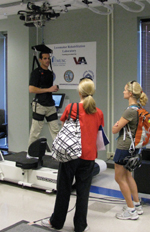 Visitors watch a demonstration of a
ZeroG mobile body weight support system in the Locomotor Rehabilitation
Lab. Visitors watch a demonstration of a
ZeroG mobile body weight support system in the Locomotor Rehabilitation
Lab.
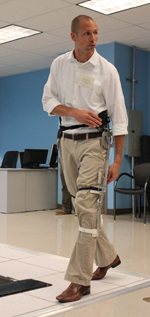 Dr. Jesse Dean demonstrates a
passive exoskeleton device. Dr. Jesse Dean demonstrates a
passive exoskeleton device.
Jim Krause, Ph.D., and
co-director of the center, set the stage for the center with his
research focus on risk assessment and prevention of adverse outcomes
for those with spinal cord injury, said Kautz. "With the new labs you
will see today, the center is building on this strength by adding a
second research focus on neurorehabilitation research that will assist
clinicians in getting the best outcome possible for each individual."
Plans for the center
include partnering with:
--The College of Medicine to incorporate the latest technologies in
neuroimaging and brain stimulation
-- The MUSC Stroke Center of Excellence to tackle the important problem
of advancing stroke rehabilitation, which is a tremendous need since
the state has the highest incidence of stroke in the country
--The MUSC/Clemson bioengineering facility being built nearby to
develop innovative new technologies
--And the Ralph H. Johnson VA Medical Center.
Kautz, a research career
scientist at the VA Medical Center, said this center provides
investigators at both institutions great opportunities to build their
research programs. MUSC President Ray Greenberg, M.D., Ph.D., agreed
saying that the center strengthens an already strong tie between the
two groups.
"So much of the work of
this center will be focused on taking care of our veteran population,
many of whom have been wounded and suffered spinal cord injuries from
their service in Iraq and Afghanistan."
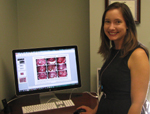 Dr. Heather Shaw Bonilha explains
the research being done in the Voice and Swallowing Lab. Dr. Heather Shaw Bonilha explains
the research being done in the Voice and Swallowing Lab.
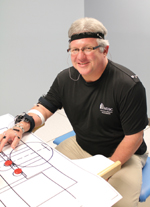 Grants
administrator Wally Pregnall shows off the PhaseSpace movement analysis
system in the upper extremity motor function lab. Grants
administrator Wally Pregnall shows off the PhaseSpace movement analysis
system in the upper extremity motor function lab.
Greenberg said the grand
opening marks a much-needed milestone in the university's history.
"It's one of the most
exciting events at the medical university—not just this year but in a
long time—because it's just such an important area, and it's been truly
underrepresented at the medical university both on the clinical and the
research side for so many years. Now we really have the growth in
neurosciences and the recruitment of a truly world-class research team
to partner with them. We have the elements of building a world-class
physical rehabilitation program."
For more information on
the center, visit its official grand opening website at http://academicdepartments.musc.edu/chp/research/centerRRNC/grandopening.htm.
Did You Know?
The 22,355 square-foot
center includes six high-tech labs in the areas of Locomotor Energetics
and Assessment, Locomotor Rehabilitation, Upper Extremity Motion
Function, Neuromuscular Assessment, Voice and Swallowing and
Neurological Conditions Research.
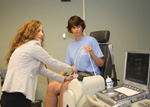 Dr. Noelle
Moreau in the Neuromuscular Assessment Lab explains her research
studying cerebral palsy in children. Dr. Noelle
Moreau in the Neuromuscular Assessment Lab explains her research
studying cerebral palsy in children.
It
is one of only five other centers with this range of capabilities in
the nation.
The
center has already created eight new jobs within the last year and
center researchers have generated $5 million in external research
funding in the first three quarters of this fiscal year.
The
center is estimated to cost $8 million
to build and sustain. It has already received a commitment for $2.3
million toward the completion of its research labs. An additional $1
million in funds for three new faculty lines will be sought through
federal grants. The remaining $5 million will need to be raised through
a combination of private and public sector contributions.
 Cutting the ribbon are: Drs. Ray Greenberg (from left), Mark Sothmann, Steve Kautz, Jim Krause and Lisa Saladin. Cutting the ribbon are: Drs. Ray Greenberg (from left), Mark Sothmann, Steve Kautz, Jim Krause and Lisa Saladin.
Continued success of this Center
will attract scholars, educators and clinical practitioners to SC, will
increase the amount of federally-sponsored research funds returning to
the state, and will contribute to economic growth in the local economy.
|



 Physical
therapy student Eric Monsch demonstrates the technology in the
locomotor analysis lab.
Physical
therapy student Eric Monsch demonstrates the technology in the
locomotor analysis lab. Visitors watch a demonstration of a
ZeroG mobile body weight support system in the Locomotor Rehabilitation
Lab.
Visitors watch a demonstration of a
ZeroG mobile body weight support system in the Locomotor Rehabilitation
Lab.  Dr. Jesse Dean demonstrates a
passive exoskeleton device.
Dr. Jesse Dean demonstrates a
passive exoskeleton device. Dr. Heather Shaw Bonilha explains
the research being done in the Voice and Swallowing Lab.
Dr. Heather Shaw Bonilha explains
the research being done in the Voice and Swallowing Lab.  Grants
administrator Wally Pregnall shows off the PhaseSpace movement analysis
system in the upper extremity motor function lab.
Grants
administrator Wally Pregnall shows off the PhaseSpace movement analysis
system in the upper extremity motor function lab. Dr. Noelle
Moreau in the Neuromuscular Assessment Lab explains her research
studying cerebral palsy in children.
Dr. Noelle
Moreau in the Neuromuscular Assessment Lab explains her research
studying cerebral palsy in children.